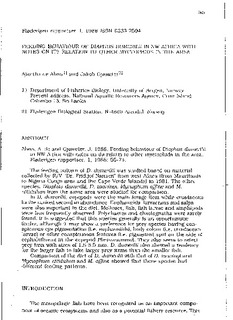Feeding behaviour of Diaphus dumerilii in NW Africa with notes on its relations to other myctophids in the area. In: Flødevigen rapportserie no 1, 1988
Research report
Permanent lenke
http://hdl.handle.net/11250/115158Utgivelsesdato
1988Metadata
Vis full innførselSamlinger
Sammendrag
The feeding pattern of D. dumerilii was studied based on material
collected by R/V "Dr. Fridtjof Nansen" from west Africa (from Mauritania
to Nigeria-Congo area and the Cape Verde Islands) in 1981. The other
species. Diaphus dumerilii, D. taaningi, Myctophum affine and M.
nitidulum from the same area were studied for comparison.
In D. dumerilii, copepods were the main forage item while crustacean
larvae ranked second in abundance. Euphausiids. larvaceans and salps
were also important in the diet. Molluscs, fish. fish larvae and amphipods
were less frequently observed. Polychaetes and chaetognaths were rarely
found. It is suggested that this species generally is an opportunistic
feeder, although it may show a preference for prey species having conspiciuous
eye pigmentation (i.e. euphausiids), body colour (i.e. crustacean
larvae) or other conspiciuous features (i.e. pigmented spot on the side of
cephalothorax in the copepod Pleuromamma). They also seem to select
prey taxa with sizes of 1.5-3.5 mm. D. dumerilii also showed a tendency
for the larger fish to take larger prey items than the smaller fish.
Comparison of the diet of D. dumerilii with that of D. taaningi and
Myctophum nitidulum and M. affine showed that these species had
different feeding patterns.
Utgiver
HavforskningsinstituttetSerie
Flødevigen rapportserie1, 1988
